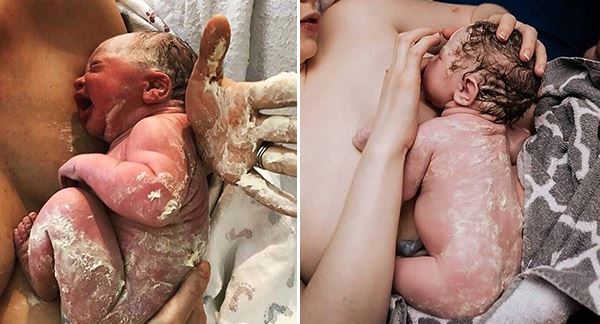
What is vernix caseosa?
The benefits of fetal sebum during and after pregnancy
Photos of babies with fetal sebum
- What is vernix caseosa?
The baby’s skin has a protective covering called vernix caseosa. It is white in color and resembles soft cheese in feel. For this reason, fetal sebum forms in the womb, and fragments of it stay attached to the baby’s skin after birth.
So what is the function of fetal sebum and why is it present? Initially, it is essential to comprehend the environment of the womb, where the baby develops. The fetus is protected by amniotic fluid for 40 weeks, and fetal sebum protects the baby’s sensitive skin. Moreover, the vernix caseosa helps to the baby’s skin being smooth and silky after birth and protects it from infection throughout gestation.
When the moment of delivery approaches, the quantity of fetal sebum diminishes, and it is completely usual to see some vernix caseosa on the infant even after birth. Thus, infants born early are likely to have even more, while those born considerably later are likely to have none at all.
- The benefits of fetal sebum during and after pregnancy
The benefits of vernix caseosa are not limited to pregnancy. Fetal sebum benefits the ???????????????? during and after ????????????????????. No matter how much or how little sebum the ???????????????? is ???????????????? with, try to keep it on the ????????????????’s skin as much as possible.
- Fetal sebum has antibacterial properties
Newborns have fragile immune systems, making them susceptible to sickness. Breastfeeding is one method for boosting a newborn’s immune, but it is not the sole one. Due to its antioxidant, anti-inflammatory, and antibacterial qualities, Vernix caseosa also protects the newborn against infection after birth.
It aids the baby’s passage through the birth canal.This layer that covers the baby’s body and head skin assists the whole birthing process owing to its texture.
It assists the infant in maintaining a consistent body temperature.Throughout pregnancy, the pregnant mother’s body plays a significant part in maintaining the baby’s body temperature, and it takes time for the newborn to be able to do so on his or her own after birth. Moreover, fetal sebum regulates the body temperature of the infant.
Hydrates the baby’s skinMoreover, fetal sebum hydrates and softens the baby’s skin after birth, preventing it from dryness.

- Photos of babies with fetal sebum
In recent years, it has become more common for couples to hire professional photographers to document the unique moments of childbirth. Among the must-have photographs are those of newborns with fetal sebum on their skin.
